Introduction
Raccoons are some of the most fascinating animals in the animal kingdom. They are highly intelligent, and they are known for their curiosity and mischievous behavior. But one thing that many people don’t think about when they think of raccoons is their poop. What does a raccoon poop look like?

In this post, we will take a look at the characteristics of raccoon poop and what it can tell us about the raccoon’s diet and health. We will also discuss the potential risks associated with raccoon poop and how to safely dispose of it. So, let’s dive in and take a closer look at what a raccoon poop looks like.
Size and Shape
Raccoon poop is usually about two to three inches in length and has a distinct shape. It is usually segmented and tapered at the ends, resembling a sweet potato or a banana. The color of raccoon poop can vary from dark brown to black, depending on the raccoon’s diet.
Raccoon poop is usually made up of small pieces of undigested food, such as seeds, nuts, and berries. It may also contain pieces of fur, feathers, or other materials that the raccoon has ingested.
Contents
Raccoon poop typically contains a variety of materials, including undigested food items, fur, feathers, and other materials. The contents of raccoon poop can provide important clues about the raccoon’s diet and health. For example, if the raccoon poop contains a lot of fur or feathers, it may indicate that the raccoon is eating a lot of small animals, such as mice and birds.
Raccoon poop may also contain parasites, such as roundworms, tapeworms, and hookworms. These parasites can be harmful to humans and pets, so it is important to avoid contact with raccoon poop.
Smell
Raccoon poop has a very distinct smell that is often described as a “musky” odor. The smell is often stronger in the summer months when the raccoon’s diet consists of more fruits and berries.
Risks
Raccoon poop can pose a number of health risks to humans and pets. Raccoons are known to carry a number of diseases, such as rabies, roundworms, and leptospirosis. In addition, raccoon poop may contain parasites, such as roundworms and tapeworms, which can be harmful to humans and pets.
It is important to avoid contact with raccoon poop, as it can contain harmful bacteria and parasites. If you come into contact with raccoon poop, it is important to wash your hands thoroughly with soap and water to avoid any potential health risks.
Disposal
Raccoon poop should be disposed of properly to avoid potential health risks. It is important to wear gloves when handling raccoon poop, as it can contain harmful bacteria and parasites. The best way to dispose of raccoon poop is to scoop it up with a shovel and place it in a plastic bag. The bag should then be sealed and disposed of in a sealed garbage can.
Conclusion
Raccoon poop can provide important clues about the raccoon’s diet and health. It is usually segmented and tapered at the ends, resembling a sweet potato or a banana. The color of raccoon poop can vary from dark brown to black, depending on the raccoon’s diet. Raccoon poop may also contain parasites, such as roundworms, tapeworms, and hookworms. It has a very distinct smell that is often described as a “musky” odor. Raccoon poop can pose a number of health risks to humans and pets, so it is important to avoid contact with raccoon poop and dispose of it properly.